| Tank | Time | Action | Implied gas temperature |
| 3L Oxygen | Sunday 1145 | Starts at 99bar left from last dive | |
| | | Fill to 230bar | 50°C |
| | Sunday 1345 | Tank cooled to 211bar | |
| | | Refill to 240bar | |
| 3L 14/50 Trimix | Sunday 1350 | Start from empty | |
| | | Add 15 bar of oxygen. | |
| | | Add helium to 134bar | 48°C |
| | Sunday 1536 | Tank has cooled to 124bar | |
| | | top up to 134bar then air top to 233bar | |
| | Sunday 1635 | Tank has cooled to 223bar | 37°C |
| | | Top to 240bar | |
| 7L 18/40 stage | Sunday 1645 | Started as 156bar of 18/30 | |
| | | Add O2 to 165bar | 28°C |
| | Sunday 1727 | Cooled to 163bar, topup | |
| | | Add helium to 220bar | 35°C |
| | Sunday 1843 | Cooled to 212bar, topup and air fill to 240bar | |
| | -not logged-- | retop up | |
| 1.5L Argon | Sunday 2126 | Slow fill to 128bar then pump to 200 | 40°C |
| | Monday 0919 | Cool to 190bar, top up | |
| 7L 50% O2 | Monday 0930 | Start at 190bar, Oxygen fill to 206bar | 30°C |
| | Monday 1038 | Cooled to 202bar, top and air fill to 240bar | 35°C |
| | Monday 1149 | Cooled to 231bar topup | |
| 3L 18/30 | Monday 1700 | Fill from empty, 16bar of O2 | |
| | Monday 1719 | Helium to 110bar | 38°C |
| | Monday 1809 | Cooled to 105bar, top up and air to 240bar | 40°C |
| | Tuesday 1327 | Cooled to 227bar topup | |
| 3L Air 300bar | Tuesday 1337 | Start at 274bar, pump to 300 | 30°C |
| | Tuesday 1938 | Cooled to 294, topup | |
 Yes you read that right! 1665bar. The ideal gas law is a joke at those
pressures but for the record that works out at 2175°C. Your aluminium tank
melted at about 650°C and your steel one at 1515°C.
Yes you read that right! 1665bar. The ideal gas law is a joke at those
pressures but for the record that works out at 2175°C. Your aluminium tank
melted at about 650°C and your steel one at 1515°C.